by K.G. Beck* (11/13)
Quick Facts…
- Leafy spurge (Euphorbia esula L.) is a creeping perennial that reproduces from seed and vegetative root buds.
- It can reduce cattle carrying capacity of rangeland or pastures by 50 to 75 percent.
- Leafy spurge is difficult to control. Its extensive root system has vast nutrient stores that let it recover from control attempts.
- Combine control methods into a system to achieve best results.
Leafy spurge (Euphorbia esula L.) is a creeping, herbaceous perennial weed of foreign origin that reproduces from seed and vegetative root buds. It can reduce rangeland cattle carrying capacity by 50 to 75 percent. About half of this loss is from decreased grass production. Cattle won’t graze in dense leafy spurge stands and these areas are a 100 percent loss to producers.
A 1990 survey found 44,000 acres in Colorado infested with leafy spurge. In 2002, the Colorado Department of Agriculture conducted a follow-up survey and found more than 73,800 infested acres of leafy spurge (Figure 1).
Leafy spurge is an erect plant that grows 1 to 3 feet tall. Leaves are bluish-green with smooth margins, 0.25 inch to 0.5 inch wide, and 1 inch to 4 inches long (Figures 2 and 3).
Umbel flowers are surrounded by heartshaped, showy, yellow-green bracts. (An umbel looks like the stays of an umbrella if it is held upside down. Figure 4.) Flowers occur in many clusters toward the top of the plant (Figure 5). Seeds are round to oblong, about 1/12 inch long, gray or mottled brown with a dark line on one side.
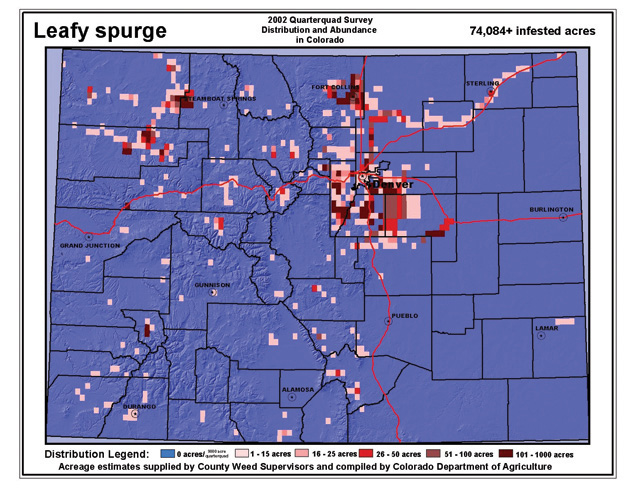
Figure 1: Leafy spurge distribution in Colorado, 2002. |
Leafy spurge contains a white milky latex in all plant parts. Latex distinguishes leafy spurge from some other weeds (e.g., yellow toadflax), particularly when plants are in a vegetative growth stage.
Leafy spurge has an extensive root system that is abundant in the top foot of soil, and it may grow 15 feet deep or more. Roots contain substantial nutrient reserves that allow the weed to recover from stress, including control efforts. Many vegetative buds along roots grow into new shoots. This contributes to its persistence and spread.
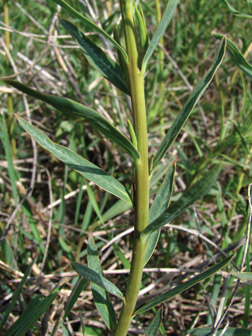
Figure 2: Leafy spurge stems and leaves |
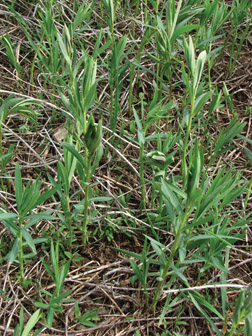
Figure 3: Leafy spurge in bolting growth stage; note leafy spurge seedlings |
Phenology
Leafy spurge shoots originate in early spring from crown tissue just below the soil surface and from sporadic buds along the root system. Leafy spurge is very competitive, one of the first plants to emerge each spring, and uses moisture and nutrients that otherwise would be available for more desirable vegetation.
Flowering occurs primarily in April and May but may occur through fall. Bracts emerge about two weeks before flowers and give leafy spurge the appearance of flowering. For optimum herbicide application timing, it is important to recognize true flower emergence.
Each flowering shoot produces an average of 140 seeds. Seeds are expelled up to 15 feet when capsules dry. They are viable up to eight years in soil. Water, birds, animals and people aid seed dispersal. Seeds readily float and waterways are good sources for new infestations.
Peak seed germination generally occurs in May (Figure 6). Seedlings quickly acquire the ability to reproduce vegetatively by developing buds on roots within 10 to 12 days after emergence. Perennial leafy spurge is more difficult to control than seedlings.
Management
Leafy spurge is difficult to manage and can recover from almost any control effort. Therefore, a management scheme that combines control methods over four to five years is recommended. Even after that time, monitor infestations for recurrence and adopt a maintenance program.
Cultural control. Vigorous grass growth is an important aspect of leafy spurge control. Over-grazing stresses grasses and makes them much less competitive with weeds, leafy spurge in particular. Irrigation, where applicable, may favor grass growth and make it more competitive with leafy spurge.
Chemical control. For optimum leafy spurge control, proper timing of herbicide application is imperative. Research from North Dakota-State University indicates that Tordon 22K (picloram) 2,4-D, Banvel/Vanquish/Clarity (dicamba) are most effective when applied in spring when true flowers emerge (not just bracts). Fall application to leafy spurge regrowth also is good timing for these herbicides. Refer to Table 1 for rates and application timings and always read the herbicide label before using the product.
Tordon is one of the most effective herbicide for leafy spurge control. Treat large, readily accessible areas for three to four consecutive years. For more remote locations, Tordon can be spot sprayed at 2/quarts/A but not more than 50% of an acre can be treated in any year. Monitor infestations after treatment and retreat with 1 quart/A of Tordon when shoot control is less than 75 percent.
Tordon may be tank-mixed with 2,4-D to provide adequate control. Apply 1 to 1.5 pints of Tordon with 1 to 1.5 quarts/A of 2,4-D in spring when leafy spurge flowers. When this application is made for three to five consecutive years, leafy spurge shoot control is generally 80 to 90 percent and cattle will feed in the area again.
Plateau (imazapic) can be used to control leafy spurge in pastures, rangeland, and non-crop areas. It can be used safely around trees but may temporarily injure cool-season perennial grasses. Apply Plateau in fall while milky latex still is present in the plant. Add a methylated seed oil to the spray solution. A liquid nitrogen fertilizer solution may be added to the spray mixture to increase weed control, but it may increase cool-season perennial grass injury. Injury tends to increase with late fall applications.
Perspective control of leafy spurge is similar to Tordon. CSU research indicates that multiple years of treatment with Perspective may be necessary but not always as consecutive year applications–a single application may control leafy spurge for two growing seasons and then a repeat application may be needed. Be certain to monitor treated sites for leafy spurge recovery and retreat when control appears to be 70% or less. A methylated seed oil or crop oil concentrate may aid leaf absorption of Perspective and often improves control. However, a non-ionic surfactant also can be used instead of the seed or crop oil.
| Table 1. Herbicide rates and application timings to control leafy spurge. | |||
| Herbicide | Rate (Product/A) |
Application timing | Comments |
| Tordon | 1 quart | Spring at flowering growth stage; or fall | May need treatment 3 to 4 years |
| Plateau | 8 to 12 fl oz | Early fall (August through October) before loss of latex | Use higher rate for older and dense stands; adds 1.5 to 2 pint/A of methylated seed oil; high rate or consecutive year treatments may injure cool season grasses |
| Paramount | 16 oz | Spring at prebloom (yellow bract stage) or in fall | Add 1.5 pt/A of a methylated seed oil or 2 pt/A of a crop oil concentrate |
| Perspective | 5.5 oz | Spring at flowering growth stage; or fall | Methylated seed oil or crop oil concentrate may aid leaf absorption of Perspective at 0.5 to 1% v/v; or use of a non-ionic surfactant at 0.25 to 0.5% v/v also is recommended |
| Banvel, Vanquish, or Clarity (dicamba) |
2 quarts | Spring at flowering growth stage; or fall | Fall applications most consistent results; may need re-treatment 2 to 4 years |
| Roundup | 1 quart each application; 2 quarts total | Apply sequentially; first application first of June and second one month later | Must be combined with grass seeding |
Paramount (quinclorac) is a highly selective herbicide and can be used to control leafy spurge in pastures, rangeland and non-crop areas. CSU research indicates that Paramount caused the least injury to desirable/native forbs and shrubs. It should be used in conjunction with a methylated seed oil or crop oil concentrate.
Banvel/Vanquish/Clarity also is effective against leafy spurge. When applied in spring at flowering for three consecutive years. Often control is not very good in the first year but improves over the next two years. At that time, a maintenance schedule that uses low rates of Banvel/Vanquish/Clarity + 2,4-D (4 to 8 ounces + 0.5 to 1 quart/A), or Tordon + 2,4-D (1 pint + 1 quart/A) as needed can be used to keep infestations under control. Note: Avoid using soil-active herbicides such as Tordon, Perspective, or Banvel/Vanquish/Clarity near windbreak plants or other desirable woody vegetation. Plant injury or death can occur. Also, do not allow any herbicide to drift onto desirable woody vegetation for the same reasons.
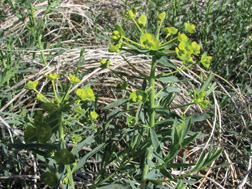
Figure 4: Leafy spurge in the early flower stage; note the heart-shaped bracts beneath developing flowers. |
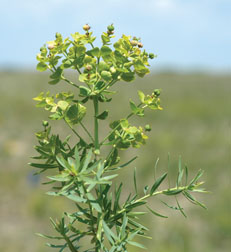
Figure 5: Leafy spurge nearing seed set growth stage; note three-lobed seed capsules above bracts. |
Roundup (glyphosate) is most effective when applied sequentially at one month intervals, coupled with fall grass seeding. Make the first application at the beginning of June and a second application one month later. Occasionally, leafy spurge will recover from these Roundup treatments. An application of 2,4-D (2.0 quart/A) in September can control regrowth. Sow perennial grasses in later fall as a dormant seeding (seed later enough that grass seedlings will not emerge until following spring).
Biological control. Sheep or goats can be used to help control leafy spurge. Research from Montana State University indicates sheep may consume up to 50 percent of their diet as leafy spurge. Introduce sheep to leafy spurge in early spring when the weed is succulent. Goats will consume leafy spurge at almost any time during the growing season.
Rotate pastures to prevent seed production and allow desirable forage plants to regain vigor. If livestock graze leafy spurge after seed formation, hold animals in a corral for at least seven days before moving them to an uninfested area. This reduces viable seed passage. Sheep or goats followed by fall herbicide treatment may be an effective, integrated means to use infested ground and control the weed.
The Colorado Department of Agriculture insectary has four flea beetles (Apthona nigriscutis, black-dot flea beetle; A. cyparissiae, brown-dot spurge flea beetle; A. czwalinae, black spurge flea beetle; and A. flava, copper spurge flea beetle) available for release. Their larvae feed on leafy spurge root hairs and within roots, while adults feed on foliage. Other insects may become available in the future. Most likely, a combination of insects will be necessary to adequately control leafy spurge. Insects would be most advantageous in areas where herbicide use is difficult or risky.
Recent research completed by Colorado State University showed that six to eight sheep per acre grazing for 10 days in July over a period of five years decreased leafy spurge density about 90 percent. When flea beetles grazed simultaneously in July with eight sheep per acre for 10 days over five years, leafy spurge density was decreased to zero.
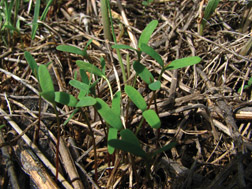
Figure 6: Leafy spurge seedlings. |
Habitat requirements of the flea beetles vary. While all requirements are not well understood, it is known that A. nigriscutis prefers open, dry sites and coarse soils low in organic matter. A. cyparissiae prefers soils higher in moisture than A. nigriscutis, but still prefers moderately coarse-textured soils such as sandy loams and open sites. A. flava does well in coarse soils with high water tables in open and shaded conditions. A. czwalinae prefers moist, clay soils.
Regardless of the management system used, a combination of methods is essential to return leafy spurge-infested ground to a productive state. The key to control leafy spurge or any creeping perennial is to exhaust the root nutrient stores, causing it to collapse. Persistence is imperative to gain control.
*Colorado State University Extension weed science specialist and professor, bioagricultural sciences and pest management. 2/00. Revised 11/13.
Colorado State University, U.S. Department of Agriculture, and Colorado counties cooperating. CSU Extension programs are available to all without discrimination. No endorsement of products mentioned is intended nor is criticism implied of products not mentioned.
Go to top of this page.





